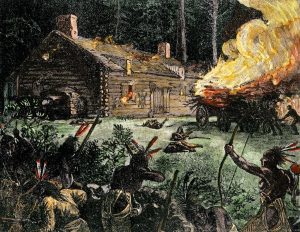 New England villages burn in King Philip's war.
New England villages burn in King Philip's war.
1675-1678, Brutal King Philip’s War erupts between once-friendly Wampanoag, supported by most neighboring tribes, and expanding colonists in Connecticut, Rhode Island and Massachusetts. Springfield and Providence are burned early in fighting. Dozens more villages, including Northampton, Hadley and Sudbury, MA, and Warwick, RI, attacked.
Colonial militia loses dozens in ambush at Bloody Creek; Narragansett band nearly wiped out in Great Swamp Massacre. Of total colonist population estimated at 16,000, more than 1,000 die in fighting; of estimated Indian population of 10,000 (previously depleted by disease), at least 3,000 die.
Many captured Indians hanged and others sold into slavery; the piked head of slain Wampanoag leader Metacom (known also as Philip) displayed in Plymouth for 20 years. Native Wabanaki, however, are victors in related Maine fighting.
1675, A female domestic slave tells her mistress of a plot to overthrow and kill white masters, May. Confessions are forced and trials held. Of 17 slaves convicted, 6 are burned to death and 11 beheaded. Another 25 are executed later in the year and 70 are flogged or deported. Quaker masters are specifically required to be more strict with their slaves under new laws.
In September, Barbados suffers a major hurricane that destroys wind-driven sugar mills and knocks down many of the trees that survived plantation-clearance.
1676, In Virginia, plantation owner Nathaniel Bacon leads rebellion of hundreds of settlers (including planters, European and African indentured servants, and slave and free blacks) against William Berkeley, colonial governor. One issue: Settlers want to take more Northern Neck land (between Rappahannock and Potomac rivers) from Doeg and other Indians, and want the right to continue to kill them indiscriminately; Berkeley wants peace. Bacon’s supporters burn Jamestown, Sept. 19. Privateer Capt. Thomas Larimore helps restore Berkeley to power, January 1677; 23 rebels hanged.
Burgesses then adopt Bacon’s policy of attacking Indians and giving much of their land to indentured servants at the end of their term. This effectively divides the indentured from slaves. Burgesses also move to ultimately reduce indentured numbers, increase slaves and, by 1705, subject latter to a more onerous slave code.
1676, French warships, led by Jean II d'Estrées, retake Cayenne from the Dutch, December, and then capture Tobago in the Caribbean and Gorée Island at Cape Verde from the British the following year. This is part of the French-Dutch War waged by Louis XIV.
French will hold Gorée (with two brief interruptions) for the next 300 years, build up Dakar on the Cape Verde peninsula and expand into Senegal.
1677, Five Nations of the Iroquois (east to west: Mohawk, Oneida, Onondaga, Cayuga and Seneca), which dominate present-day upstate New York for more than a century (thanks to innovative production of corn, beans and squash), agree to Covenant Chain alliance with British. This holds through the French & Indian War, although they divide during the American Revolution.
1680, Beset by drought, Comanche raids and onerous Spanish rule, thousands of Pueblo people rise up in New Mexico, Aug. 10. 400 Spanish settlers, including women and children are killed, also 21 Franciscan missionaries. All Spanish settlements destroyed. Santa Fé is beseiged for months; the governor, Antonio de Oterman, finally leads a break out toward El Paso, Jan. 1. Nearly 2,000 make it, including 500 Indian slaves.
Popé, the Pueblo leader, urges return to old ways and destruction of all things Spanish, including churches. A Spanish attempt to regain control in 1681 is turned back. It will be another 11 years before they try again.
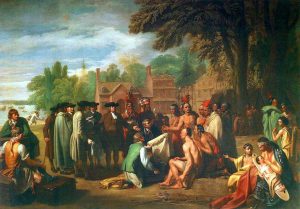 1681, William Penn, a Quaker leader in England, wins charter from Charles II to establish colony of Pennsylvania (in partial payment of a royal debt). This is six years after Quakers first settle Delaware valley.
1681, William Penn, a Quaker leader in England, wins charter from Charles II to establish colony of Pennsylvania (in partial payment of a royal debt). This is six years after Quakers first settle Delaware valley.
On site of what will become Philadelphia, Penn pays for land again, in treaty with Lenape chief Tammany, 1683. By 1720 Philadelphia is second to Boston in population, 10,000 to 12,000, including perhaps 200 slaves. New York is third in the 13 colonies with 7,000 people.
Tammany (Tamenend) becomes a symbol of peace and amity, celebrated in Philadelphia, and up and down colonial coast.
1681, René-Robert Cavelier de la Salle descends the Mississippi from the Illinois river to reach the Gulf of Mexico in April, 1682. He names the entire Mississippi basin “Louisiana” and claims it for France and his patron, Louis XIV.
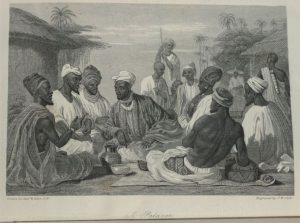 1682, Oyo Empire begins expansion to the west and to the coast. By 1700, the Ewe and Aja peoples are paying tribute to Oyo (Yoruba people).
1682, Oyo Empire begins expansion to the west and to the coast. By 1700, the Ewe and Aja peoples are paying tribute to Oyo (Yoruba people).
1683, South Carolina passes Act to Prevent Runaways.
1684-1687, La Salle sails from La Rochelle with four ships provided by Louis XIV, and 380 soldiers and settlers determined to establish a colony at the mouth of the Mississippi. One ship is lost to pirates off Hispaniola and another runs aground shortly after expedition struggles into Matagorda Bay (present-day Texas), having overshot the Mississippi by 500 miles, January 1685.
A third ship soon heads back to France. When the last ship, La Belle, sinks in the bay, La Salle attempts to find Mississippi overland. On fourth attempt, his men mutiny and kill him, March 19, 1687. Six of these men eventually find their way to Canada.
Remaining adults are killed the following year by Karankawas Indians who take children captive.
1684, Isabella, first slave ship to Philadelphia, delivers 150 Africans.
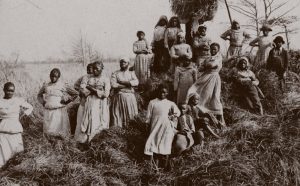 Groups of slaves cultivate rice to be brought to Charles Town.
Groups of slaves cultivate rice to be brought to Charles Town.
1685, Rice introduced to South Carolina via a trading ship from Madagascar forced to put into Charles Town for storm repair (according to most sources). Henry Woodward, among the city’s first settlers, plants rice with great success on his John’s Island plantation.
By 1700, the province is shipping nearly 200 tons annually. By 1800, 100 times that weight is shipped, and Low Country rice planters become one of the richest groups in the colonies (wealth made possible in large part by Wolof and Jola slaves knowledgeable about rice cultivation in their native Senegambia deltas).
Labor-intensive: After salt-water recedes from estuaries, they must be dammed off, allowing the fields to fill with fresh water. Then rice is planted, to be cultivated by hand. Management and maintenance of waterworks is critical.
1685, Louis XIV decrees Code Noir to regulate slavery in French colonies. Slaves must be baptized into Catholicism (also, Jews must leave French colonies).
Onerous overall, but with some big differences compared to British colonies: Families should not be broken up; masters may strike, but cannot torture or mutilate; Indians and freed slaves gain some rights of white colonial subjects (but usually not the right to vote). Inspired by Catholic priests on Martinique and drawn up by Louis’ minister, Jean-Baptiste Colbert and son.
Despite upholding much brutality, code makes possible surprisingly large populations of free people of color in French colonies, including Saint-Domingue, Martinique and Louisiana.
1685-1690, Crops fail for lack of rain in Cape Verde Islands; 4,000 die on Santiago. First of eight multi-year droughts that devastate the islands through 1866, with 20,000-plus dying in 1773-75 and a full 25% of the population succumbing in 1854-56. Thousands migrate to São Tomé and the Americas.
1686, New France’s Gov. Jacques-René de Denonville takes 50 Iroquois sachem prisoner at supposed Fort Frontenac peace meeting (present-day Kingston, ON). They are shipped to Marseille to serve as galley slaves. Iroquois raids intensify in St. Lawrence valley, hundreds of farms burned and families killed; Montreal continually threatened.
Louis de Buade de Frontenac returns to replace De Denonville, and eventually retrieves 13 surviving sachem from France. He restores them to Iroquois in bid to win a peace.
1687, British crown’s customs revenue on sugar and tobacco (virtually all produced on slave plantations in the Americas), cover a third of cost of the king’s navy, army and government.
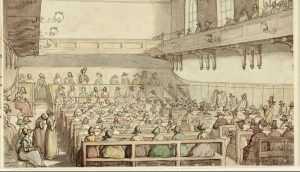 Quakers gathered at town hall meeting near Philadelphia.
Quakers gathered at town hall meeting near Philadelphia.
1688, Dutch and German Quakers issue what is believed to be the first anti-slavery statement by a religious group, in Germantown, near Philadelphia. They cite New Testament, “Do unto others as you would have them do unto you.”
Over the following century, it is the Quakers in America and in Britain who alone consistently call and organize for an end to the slave trade. They encourage Quaker slaveholders to improve conditions, to educate slaves and, finally, to free them.
1688, In England’s “Glorious Revolution,” William of Orange and Mary (James II’s daughter) with large Dutch fleet land at Torbay, Nov. 5; James’s army and fleet go over to them. James flees London for France and is ultimately defeated at the Battle of the Boyne in Ireland, July 1, 1690.
From this point on, Britain rises and Netherlands fade as a leading sea and trade power (despite fact that the Dutch leader has taken over Britain as William III).
Britain also takes part in Nine Years’ War, which involves a coalition against France and Louis XIV, through 1697.
1688-1697, King William’s War between the New England colonies and New France, and their respective Indian allies, is an extension of both the ongoing Beaver Wars over fur trade and the Nine Years’ War in Europe.
On the fuzzy Maine border with Acadia (present-day New Brunswick and Nova Scotia) and in upper New York, fighting is characterized by back-and-forth raids, ambushes, bloody massacres (particularly at Schenectady, NY, and Fort Loyal, ME), and kidnapping of women and children. Port Royal, the Acadian capital, is burned while well-fortified Québec City fights off British attackers. Treaty restores borders as they were; Iroquois and French (led by Frontenac) manage to end longstanding conflict.
Witch Trials: Salem, MA, witch trials take place amid this fighting, May 1693. More than 200 are initially accused, 30 are found guilty, 14 women and 5 men are hanged, and one elderly man is “pressed” to death. Some scholars believe terrors of Indian wars fed fears of witchcraft.
1689, With King James gone, the London-based Royal African Company loses monopoly control of African trade. But Edward Colston, the company’s deputy governor, transfers a large shareholding to William III to gain some favor with the new monarch.
(In 2020, protestors in Bristol pull down a 291-year-old statue of slave-trading Colston, tossing it into the River Avon).
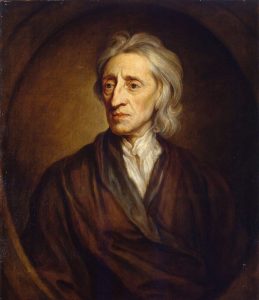 John Locke.
John Locke.
1689, William and Mary accept English Bill of Rights, which spells out Parliament’s powers, basic civil rights and designates them as co-monarchs, Dec. 16.
Advising them is John Locke, who publishes Two Treatises on Government and other works that will have major influence on the political thinking of the Enlightenment and on Jefferson, Adams, Washington and other leaders of the American Revolution.
Note: In the Second Treatise, Locke writes that man cannot agree to enslave himself; nor do others have the right to enslave him, except if he is a captive in a just war and the alternative is death. Locke neither attacks nor makes any defense of black chattel slavery, even though he previously transcribed North Carolina’s colonial constitution, including provisions for slavery.
1690s, Estimated number of African captives crossing the Atlantic reaches 30,000 a year. In the 1790s, it will be 85,000 a year.
1690, The New-England Primer, the first reading-instruction book for young students in the 13 colonies, is published in Boston by Benjamin Harris. It is based on The Protestant Primer, which he had published in London (along with anti-Catholic pamphlets).
The Primer will be the basis of most colonial schooling through the Revolutionary War.
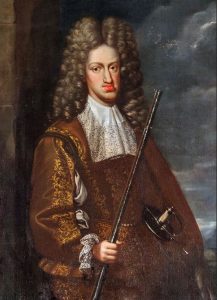 King Charles II of Spain.
King Charles II of Spain.
1691, The Palenque de San Basilio, the maroon village in present-day Colombia founded in 1605 by Benkos Biohó, is granted a royal charter of freedom by King Charles II of Spain. This ends decades of futile attempts to storm the mountain stronghold, although viceroyalty of Cartagena does not acknowledge free status until 1714.
1692, Diego de Vargas leads Spanish return to New Mexico and Santa Fé, Sept. 13. Promises clemency and protection if they will accept Christian faith. Peace is difficult; two more bloody uprisings take place before Spanish are re-established, 1699.
But they make no further attempts to interfere in Pueblo culture or religion, and grant considerable land to each Pueblo village. Also, a public defender is named to represent Indians in court.
1692, Earthquake and tsunami destroy most of Port Royal, Jamaica, June 7. One of the largest towns in the West Indies, it loses four forts and half its 6,000 population between earthquake and subsequent disease. Survivors move across bay to Kingston.
1693, College of William and Mary is founded by Anglican churchman James Blair in Middle Plantation, VA (later Williamsburg). The second-oldest college in the U.S. is named for the British king and queen.
1693, Spain’s Charles II orders that sanctuary be provided in Spanish Florida for slaves escaping from South Carolina if they convert to Catholicism and agree to serve four years in the colony’s militia, November. Extended in 1733 by his successor, Philip V.

1693-1695, Brazilian bandeirantes, in pursuit of Indians to enslave and long on the lookout for gold, discover the latter in the streams of present-day Minas Gerais. This touches off a multi-decade gold rush that draws 400,000 Portuguese and other Europeans, and 500,000 slaves by 1750, including tens of thousands from the sugar plantations of Bahia and Pernambuco.
A new rough-and-tumble city, Ouro Preto (Black Gold), grows into South America’s largest (population 40,000 in 1730), while gold mined from streams by mostly African slaves pours into the treasury of Portugal’s kings.
It is the longest gold rush in history, generating 800 tons of gold over the next century. It redirects the viceroyalty’s energy and people to southern Brazil, depleting the sugar plantations of slave labor. The capital of the new viceroyalty of Brazil is thus moved south to Rio de Janeiro in 1763 from Salvador in Bahia.
1694-1700, On-and-off Komenda Wars, between Dutch established in this Gold Coast port and encroaching British, draw in the king of Eguafo, a rival prince, and eventually the Twifo and Denkyira peoples. Dutch remain a force on the coast but British gain important foothold.
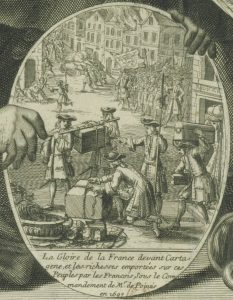
1697, A fleet of French privateers led by Bernard Desjean, Baron de Pointis, descends on Cartagena de Indias, whose decaying forts are easily taken, May 6. The French methodically plunder the city for 17 days, accumulating more than 10 million livres worth of loot.
De Pointis avoids a joint British and Dutch fleet led by John Nevell who manages to capture only a single ship whose crew is infected with yellow fever. The disease kills 1,300 British sailors, six captains and Nevell himself. The fever had previously spread to French ships on which more than 100 die.
De Pointis gives King Louis XIV his 10% share and keeps the rest, achieving instant super-wealth. His buccaneer allies, left behind in the Caribbean, return to Cartagena and pillage it all over again.
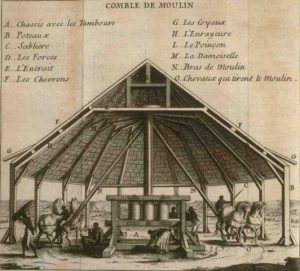 Sugar-cane mill.
Sugar-cane mill.
1697, France formally granted the Saint-Domingue end of Hispaniola (including Tortuga) from Spain in the Peace of Ryswick ending the Nine Years’ War between Louis XIV’s France and the “Grand Alliance” of Spain, Britain, Emperor Leopold I and the Dutch Republic.
Saint-Domingue, which French actually took over in 1659, develops into the richest single European colony, based on slave-powered sugar-cane production.
1697, William III and Parliament end the Royal African Company's London-based legal monopoly on trade in Africa. They do so at urging of Bristol’s would-be slave merchants.
1698-1699, Four severe winters and failed harvests lead to famine in Scotland and drive thousands to Ulster, adding to the population of Protestant Scots-Irish tenant farmers (brought in by English kings throughout the 17th century), who soon claim the majority in Ulster.
1698-1699, Smallpox, followed by an earthquake and yellow fever, kills as much as 25% of the people of Charles Town, SC, now located on its present site between the Ashley and Cooper rivers (both named after Ashley-Cooper, Earl of Shaftesbury).
1699, Scottish settlers abandon an 8-month attempt to create a New Caledonia on the Darien coast of the Panama isthmus. Only 300 of original 1,200 survive malaria, yellow fever and hunger, July.
An increasingly desperate Scotland—nobles, merchants, clerics—had pooled considerable assets into the Scotland Company to establish a colony that could straddle the isthmus, create a new highway for trade to the Pacific, and build wealth to support some level of Scottish independence from England.
A second expedition of five ships and 1,000 settlers arrives Nov. 30 to find New Caledonia deserted and are soon beseiged by a Spanish force. The Scots negotiate their final departure, February, 1700.
The loss in capital to Scotland is so great that it begins negotiating the Acts of Union that will be voted in 1707, establishing a much more united Great Britain dominated by England.
1699, Henrietta Marie departs England for New Calabar (present-day Nigeria). Trades iron bars and pewter goods for slaves, 191 of whom are then delivered to Port Royal, Jamaica.
Ship loads final cargo of Jamaica sugar, cotton and dyewoods for England. Detours via Yucatán Channel to avoid Windward Passage pirates, only to founder. No survivors from crew of about 18. Ship’s fate unknown until discovered on New Ground Reef, off Key West, in 1972.
